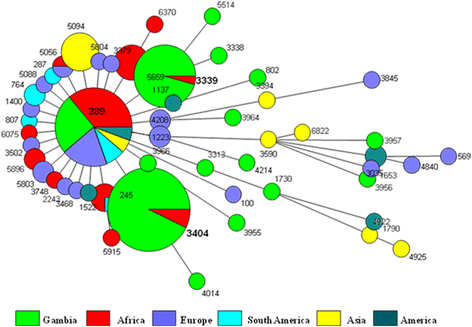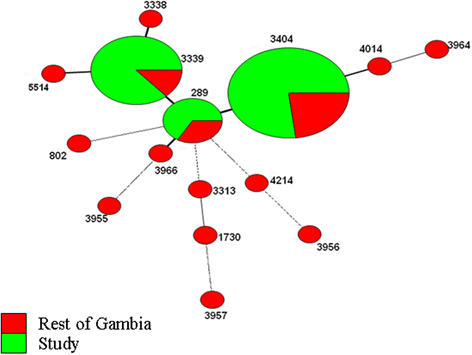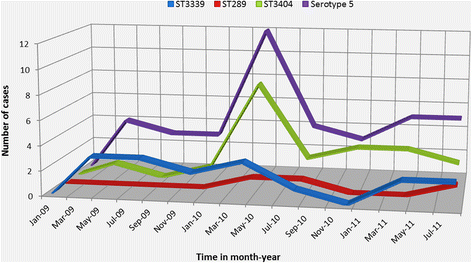Population structure, epidemiology and antibiotic resistance patterns of Streptococcus pneumoniae serotype 5: prior to PCV-13 vaccine introduction in Eastern Gambia
- PMID: 26822883
- PMCID: PMC4731921
- DOI: 10.1186/s12879-016-1370-0
Population structure, epidemiology and antibiotic resistance patterns of Streptococcus pneumoniae serotype 5: prior to PCV-13 vaccine introduction in Eastern Gambia
Abstract
Background: Streptococcus pneumoniae serotype 5 is among the most common serotypes causing invasive pneumococcal disease (IPD) in The Gambia. We anticipate that introduction of the 13-valent pneumococcal conjugate vaccine (PCV-13) into routine vaccination in The Gambia will reduce serotype 5 IPD. However, the emergence of new clones that have altered their genetic repertoire through capsular switching or genetic recombination after vaccination with PCV-13 poses a threat to this public health effort. In order to monitor for potential genetic changes post-PCV-13 vaccination, we established the baseline population structure, epidemiology, and antibiotic resistance patterns of serotype 5 before the introduction of PCV-13.
Methods: Fifty-five invasive S. pneumoniae serotype 5 isolates were recovered from January 2009 to August 2011 in a population-based study in the Upper River Region of The Gambia. Serotyping was done by latex agglutination and confirmed by serotype-specific Polymerase Chain Reaction (PCR). Genotyping was undertaken using Multilocus Sequence Typing (MLST). Antimicrobial sensitivity was done using disc diffusion. Contingency table analyses were conducted using Pearson's Chi(2) and Fisher's exact test. Clustering was performed using Bionumerics version 6.5.
Results: MLST resolved S. pneumoniae serotype 5 isolates into 3 sequence types (ST), namely ST 289(6/55), ST 3339(19/55) and ST 3404(30/55). ST 289 was identified as the major clonal complex. ST 3339, the prevalent genotype in 2009 [84.6% (11/13)], was replaced by ST 3404 [70.4% (19/27)] in 2010 as the dominant ST. Interestingly, ST 3404 showed lower resistance to tetracycline and oxacillin (P < 0.001), an empirical surrogate to penicillin in The Gambia.
Conclusions: There has been an emergence of ST 3404 in The Gambia prior to the introduction of PCV-13. Our findings provide important background data for future assessment of the impact of PCV-13 into routine immunization in developing countries, such as The Gambia.
Figures



Similar articles
-
CIRCULATING CLONAL COMPLEXES AND SEQUENCE TYPES OF STREPTOCOCCUS PNEUMONIAE SEROTYPE 19A WORLDWIDE: THE IMPORTANCE OF MULTIDRUG RESISTANCE: A SYSTEMATIC LITERATURE REVIEW.Expert Rev Vaccines. 2021 Jan;20(1):45-57. doi: 10.1080/14760584.2021.1873136. Epub 2021 Feb 17. Expert Rev Vaccines. 2021. PMID: 33507135
-
Epidemiological and molecular characterization of Streptococcus pneumoniae carriage strains in pre-school children in Arkhangelsk, northern European Russia, prior to the introduction of conjugate pneumococcal vaccines.BMC Infect Dis. 2020 Apr 15;20(1):279. doi: 10.1186/s12879-020-04998-5. BMC Infect Dis. 2020. PMID: 32293324 Free PMC article.
-
Serotype distribution and antibiotic resistance of Streptococcus pneumoniae isolates from 17 Chinese cities from 2011 to 2016.BMC Infect Dis. 2017 Dec 29;17(1):804. doi: 10.1186/s12879-017-2880-0. BMC Infect Dis. 2017. PMID: 29284419 Free PMC article.
-
Antibiotic resistance pattern, capsular types, and molecular characterization of invasive isolates of Streptococcus pneumoniae in the south of Tunisia from 2012 to 2018.BMC Microbiol. 2023 Feb 4;23(1):36. doi: 10.1186/s12866-023-02784-2. BMC Microbiol. 2023. PMID: 36739390 Free PMC article.
-
Impact of pneumococcal conjugate vaccine on infections caused by antibiotic-resistant Streptococcus pneumoniae.Clin Microbiol Infect. 2009 Apr;15 Suppl 3:16-20. doi: 10.1111/j.1469-0691.2009.02726.x. Clin Microbiol Infect. 2009. PMID: 19366365 Review.
Cited by
-
Incidence of macrolide-lincosamide-streptogramin B resistance amongst beta-haemolytic streptococci in The Gambia.BMC Res Notes. 2017 Feb 23;10(1):106. doi: 10.1186/s13104-017-2427-x. BMC Res Notes. 2017. PMID: 28231812 Free PMC article.
-
A Systematic Overview of Type II and III Toxin-Antitoxin Systems with a Focus on Druggability.Toxins (Basel). 2018 Dec 4;10(12):515. doi: 10.3390/toxins10120515. Toxins (Basel). 2018. PMID: 30518070 Free PMC article.
-
Development of PCRSeqTyping-a novel molecular assay for typing of Streptococcus pneumoniae.Pneumonia (Nathan). 2017 May 25;9:8. doi: 10.1186/s41479-017-0032-3. eCollection 2017. Pneumonia (Nathan). 2017. PMID: 28702310 Free PMC article.
-
Seeking diagnostic and prognostic biomarkers for childhood bacterial pneumonia in sub-Saharan Africa: study protocol for an observational study.BMJ Open. 2021 Sep 30;11(9):e046590. doi: 10.1136/bmjopen-2020-046590. BMJ Open. 2021. PMID: 34593486 Free PMC article.
-
The Molecular Approaches and Challenges of Streptococcus pneumoniae Serotyping for Epidemiological Surveillance in the Vaccine Era.Pol J Microbiol. 2023 Jun 14;72(2):103-115. doi: 10.33073/pjm-2023-023. eCollection 2023 Jun 1. Pol J Microbiol. 2023. PMID: 37314355 Free PMC article. Review.
References
-
- Ryan KJ. Streptococci and Enterococci. In: Sherris JC, Ryan KJ, Ray CG (eds) Medical Microbiology: An Introduction to Infectious Diseases. Fourth Edition. McGraw-Hill, USA. 2004;273–296.
-
- Antonio M, Dada-Adegbola H, Biney E, Awine T, O’Callaghan J, Pfluger V, et al. Molecular epidemiology of pneumococci obtained from Gambian children aged 2–29 months with invasive pneumococcal disease during a trial of a 9-valent pneumococcal conjugate vaccine. BMC Infect Dis. 2008;8:81. doi: 10.1186/1471-2334-8-81. - DOI - PMC - PubMed
MeSH terms
Substances
Grants and funding
LinkOut - more resources
Full Text Sources
Other Literature Sources
Medical
Molecular Biology Databases

